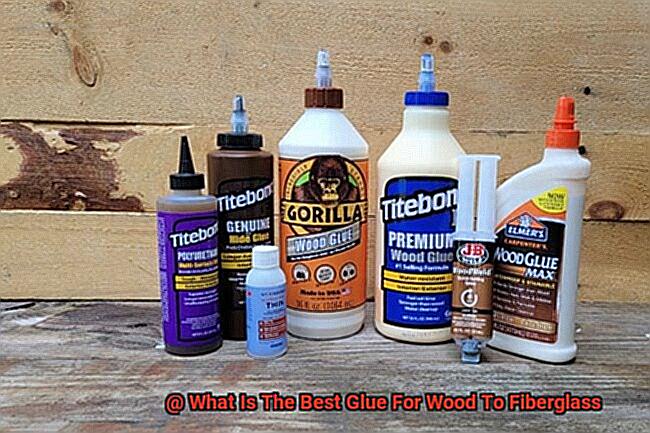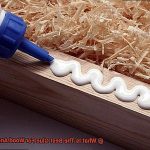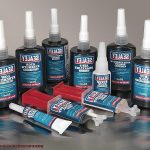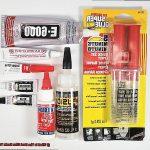When it comes to melding wood and fiberglass together, you’re faced with a unique challenge. These two materials possess their own distinct characteristics, demanding an adhesive that can create a bond as strong as steel. Whether you’re a woodworking wizard or a construction connoisseur, finding the best glue for wood to fiberglass is the secret ingredient that can make or break your project.
Now, hold on tight because not all glues are created equal. Choosing the wrong one could result in a feeble bond that crumbles under pressure. You need an adhesive that not only clings to both wood and fiberglass with unwavering tenacity but also withstands environmental onslaughts like moisture, temperature swings, and chemical exposure.
In this comprehensive guide, we’re about to unravel the enigma behind the ultimate glue for wood to fiberglass bonding. We’ll dive into a sea of factors you should consider when making your selection: adhesion strength, curing time, compatibility with different materials, ease of application – just to name a few. So whether you’re building boats or crafting woodworking wonders, get ready to embark on an adhesive adventure and discover the holy grail of wood-to-fiberglass bonds. Let’s dive in.
Types of Glue for Wood-to-Fiberglass Bonding
Contents
- 1 Types of Glue for Wood-to-Fiberglass Bonding
- 2 Advantages and Disadvantages of Epoxy Resin
- 3 Advantages and Disadvantages of Polyurethane Adhesive
- 4 Other Glues Not Suitable for Wood-to-Fiberglass Bonding
- 5 Preparing Surfaces for Glue Application
- 6 Tips for Choosing the Best Glue for Wood to Fiberglass
- 7 Benefits of Using the Right Glue
- 8 Steps to Follow When Applying the Best Glue
- 9 Conclusion
Finding the right glue for wood-to-fiberglass bonding is crucial for ensuring a strong and durable bond in woodworking projects involving fiberglass. In this article, we will explore the different types of glue commonly used for this purpose and discuss their advantages and disadvantages, allowing you to make an informed decision for your next project.
Epoxy Resin: The Reliable Powerhouse
Epoxy resin is the undisputed champion when it comes to wood-to-fiberglass bonding. Its exceptional bonding strength and durability make it the go-to choice for applications exposed to water, chemicals, and temperature fluctuations. With proper mixing of resin and hardener, epoxy resin creates a bond stronger than the materials being joined together, ensuring a long-lasting result.
Polyurethane Adhesive: Flexibility at Its Best
Polyurethane adhesive offers flexibility and a strong bond for joining wood to fiberglass. It excels at filling gaps and bonding uneven surfaces, making it perfect for projects that require adaptability. Additionally, polyurethane adhesive provides resistance against water and heat, making it suitable for outdoor applications where exposure to the elements is unavoidable.
Contact Cement: Fast and Furious
If you’re seeking an instant bond, contact cement is your weapon of choice. This type of glue creates a quick and robust bond when two surfaces are pressed together. Its ease of application makes it a popular option, although it may not provide the same level of durability or longevity as epoxy resin or polyurethane adhesive.
Cyanoacrylate (Super Glue): Small-Scale Savior
When working on small-scale wood-to-fiberglass projects, super glue, or cyanoacrylate, can come to the rescue. It forms a fast and strong bond; however, its brittle nature may not withstand stress or vibrations as well as other glues. Therefore, it is best suited for projects with minimal movement or strain.
Marine Adhesive/Sealant: Tackling Harsh Environments
For marine applications like boat building or repair, marine adhesive or sealant is specifically designed to withstand water, salt, and UV exposure. These adhesives offer excellent bonding strength and flexibility, ensuring a durable bond even in the harshest conditions.
Choosing the right glue for wood-to-fiberglass bonding depends on various factors such as strength, durability, flexibility, and resistance to environmental elements.
Epoxy resin and polyurethane adhesive are often recommended due to their exceptional bonding strength and resistance to water and temperature changes.
However, it’s crucial to follow the manufacturer’s instructions and properly prepare the surfaces for optimal results.
Advantages and Disadvantages of Epoxy Resin
When it comes to bonding wood to fiberglass, epoxy resin stands out as a reliable powerhouse. Its exceptional strength and durability make it a popular choice among DIYers and professionals alike. However, like any adhesive, epoxy resin has its advantages and disadvantages. In this article, we will delve into the pros and cons of using epoxy resin for wood-to-fiberglass bonding, providing you with the information you need to make an informed decision for your next project.
Advantages of Epoxy Resin:
- Strong bond: Epoxy resin is renowned for creating a strong and durable bond between wood and fiberglass. Whether you’re working on boat repairs or crafting custom furniture, epoxy resin ensures a secure attachment that will withstand the test of time.
- Versatility: One of the major advantages of epoxy resin is its versatility. It adheres well to both wood and fiberglass surfaces, making it an excellent choice for bonding the two together. This flexibility opens up a world of possibilities for various applications.
- Waterproof properties: Water can wreak havoc on wood-to-fiberglass bonds, but epoxy resin has excellent water resistance. This feature ensures that your bond remains intact even in wet or humid conditions, making it ideal for outdoor projects or marine applications.
- Chemical resistance: Epoxy resin is highly resistant to chemicals such as solvents, acids, and alkalis. This makes it suitable for applications where exposure to these substances is expected, such as industrial settings or chemical laboratories.
Disadvantages of Epoxy Resin:
- Cost: One drawback of using epoxy resin is its cost. Compared to other types of adhesives, epoxy resin tends to be more expensive. If you’re working on a tight budget or require a large amount of adhesive for your project, this cost factor may be a limiting factor.
- Mixing and curing time: Epoxy resin requires precise mixing of its two components – the resin and the hardener. This process must be done accurately to ensure proper curing. Additionally, epoxy resins often have longer curing times compared to other adhesives, which can extend your project timeline.
- Toxicity concerns: It’s important to note that certain epoxy resins contain harmful chemicals that can release toxic fumes during the curing process. To minimize exposure to these fumes, it is crucial to use epoxy resin in a well-ventilated area or with appropriate protective equipment.
- Brittleness when cured: Once cured, epoxy resin can become rigid and brittle. While this property can be advantageous in certain applications, it can also make the bond susceptible to cracking or breaking under high stress or impact. Consider the specific demands of your project before using epoxy resin in high-stress areas.
Advantages and Disadvantages of Polyurethane Adhesive
When it comes to bonding wood to fiberglass, selecting the right adhesive is essential for a sturdy and long-lasting connection. Polyurethane adhesive is a popular option that offers several advantages, but it’s important to weigh them against its disadvantages. In this article, we will delve into the pros and cons of using polyurethane adhesive for wood to fiberglass applications, providing you with the information needed to make an informed decision for your project.
Advantages of Polyurethane Adhesive:
Strong Bond:
Polyurethane adhesive excels at creating a robust and durable bond between wood and fiberglass. This ensures that your project will have a reliable connection capable of withstanding various stresses and strains.
Flexibility:
One of the standout advantages of polyurethane adhesive is its versatility in application. It works effectively on both porous and non-porous surfaces, making it suitable for bonding different types of wood to fiberglass. Furthermore, it can be applied at various thicknesses, allowing for adaptability in diverse projects.
Water Resistance:
Polyurethane adhesive boasts excellent water resistance properties. Once cured, it forms a waterproof seal that prevents moisture from infiltrating the bond line. This makes it perfect for applications exposed to water or high humidity, such as boat construction or outdoor furniture assembly.
Gap Filling Capability:
Another advantage of polyurethane adhesive is its ability to fill gaps between materials. It adeptly bridges small gaps or irregularities in the surfaces being bonded, creating a solid connection even in less-than-ideal conditions.
Disadvantages of Polyurethane Adhesive:
Long Curing Time:
One drawback of polyurethane adhesive is its relatively lengthy curing time. It typically requires several hours to fully cure, which can be inconvenient if you’re working on a project with tight deadlines. However, it’s worth noting that fast-curing variants are available to address this drawback.
Limited Shelf Life:
Polyurethane adhesive has a limited shelf life once opened. It tends to react with moisture in the air, gradually thickening and becoming unusable over time. To maximize its shelf life, it’s crucial to check the expiration date and store the adhesive properly.
Potential Health Hazards:
While polyurethane adhesive is generally safe to use when handled correctly, it can emit strong fumes during the curing process. These fumes may cause irritation to the eyes, nose, and throat. It is important to work in a well-ventilated area or wear appropriate personal protective equipment.
Difficult Cleanup:
Polyurethane adhesive is renowned for its strong bond, which can make cleanup challenging. Once cured, it forms a solid and rigid bond that is difficult to remove. It’s imperative to clean up any excess adhesive immediately before it dries to avoid unwanted residue.
Other Glues Not Suitable for Wood-to-Fiberglass Bonding
Wood-to-fiberglass bonding is a delicate dance that requires the perfect glue partner. Unfortunately, not all glues are cut out for this tango. Let’s explore why water-based glues, epoxy-based glues with low bonding strength, super glues (cyanoacrylate), and contact adhesives fall flat in this intricate routine.
Water-based glues may have their moments of glory, but wood-to-fiberglass bonding is not their forte. These glues suffer from a fatal flaw – they weaken when faced with moisture or water. Imagine the bond breaking down over time like a crumbling sandcastle on the beach. To achieve a lasting connection between wood and fiberglass, opt for a glue that can resist the elements.
Epoxy-based glues are the rockstars of adhesives, but not all of them can rock the wood-to-fiberglass stage. Some epoxy glues have weak bonding strength and can’t provide the sturdy embrace required for this performance. To ensure a reliable bond, choose an epoxy glue specially crafted for wood-to-fiberglass bonding.
Super glues may be superheroes in their own right, but they lack the power to conquer wood-to-fiberglass bonding. These glues excel on non-porous surfaces, but wood and fiberglass possess different traits. This mismatch results in a weaker, less durable connection. Furthermore, super glues can grow brittle over time, which doesn’t bode well for flexibility.

Contact adhesives, like rubber cement or neoprene-based adhesives, have their merits elsewhere, but not in wood-to-fiberglass bonding. Their reliance on solvent evaporation fails to provide sufficient strength for this task. Moreover, these adhesives may crumble under pressure from moisture or heat, endangering the bond between wood and fiberglass.
To avoid a sticky situation, choose a glue specifically designed for wood-to-fiberglass bonding. These glues boast excellent adhesion, weather resistance, and flexibility to accommodate the movement of the bonded surfaces. Invest wisely and create wood-to-fiberglass bonds that will withstand the test of time.
Preparing Surfaces for Glue Application
Preparing surfaces for glue application is a crucial step in ensuring a strong and durable bond between wood and fiberglass. To maximize the adhesive’s grip and bond strength, it is essential to follow these steps:
- Thoroughly clean the surfaces: Dirt, dust, oil, or grease can hinder the bonding process. Use a mild detergent or solvent to scrub the surfaces and rinse them with clean water. Allow them to dry completely before proceeding.
- Roughen the surfaces: Increase the adhesive’s ability to grip onto the materials by sanding or abrading them. Use fine-grit sandpaper or a wire brush to create a slightly rough texture. Remember to sand in the direction of the wood grain to avoid damaging the fibers.
- Wipe down the surfaces: After sanding, remove any dust or debris generated by wiping the surfaces with a tack cloth or a clean, lint-free cloth. This step ensures a clean working surface for optimal adhesion.
- Apply a primer or bonding agent: Enhance the bond strength by using a primer or bonding agent specifically designed for wood to fiberglass adhesion. Follow the manufacturer’s instructions and apply a thin coat. Allow it to dry completely before moving on to the next step.
- Align the surfaces: Before applying glue, ensure that both the wood and fiberglass surfaces are properly aligned. This will prevent any misalignment issues once the adhesive is applied and ensure an even distribution of glue.
Tips for Choosing the Best Glue for Wood to Fiberglass
When it comes to bonding wood to fiberglass, selecting the right glue is essential for a strong and durable bond. With numerous options available, it can be challenging to choose the best adhesive for your project. This comprehensive guide will walk you through the key factors to consider when selecting the perfect glue for wood to fiberglass bonding.
Factor 1: Material Compatibility
Before choosing a glue, it’s important to understand the properties of wood and fiberglass. Look for adhesives specifically designed for bonding these materials together. Glues that mention wood and fiberglass compatibility on their packaging or product description are your best bet.
Factor 2: Strength and Flexibility
Consider the strength of the bond required for your project. Epoxy resin and polyurethane adhesives are popular choices due to their exceptional bonding strength. Epoxy forms an incredibly strong bond, making it ideal for load-bearing applications like boat construction. Polyurethane adhesives offer high strength along with flexibility, ensuring the bond can withstand the expansion and contraction of wood and fiberglass.
Factor 3: Durability
Think about the durability of the glue, especially if your project will face harsh conditions or heavy use. Epoxy resin is known for its exceptional durability, making it a top choice for marine applications. It can withstand exposure to water, chemicals, and temperature changes without deteriorating.
Factor 4: Water Resistance
If your project involves water exposure, selecting a glue with excellent water resistance is crucial. Epoxy resin is highly resistant to water, making it ideal for applications like boat repairs or outdoor furniture exposed to moisture. Some polyurethane adhesives also offer good water resistance, but always check the product specifications before making a decision.
Factor 5: Cost
Consider your budget when choosing the best glue for wood to fiberglass bonding. Epoxy resin tends to be more expensive than other adhesives, but its superior strength and durability make it a worthwhile investment for critical applications. Polyurethane adhesives are often more cost-effective while still providing satisfactory bonding performance.
Benefits of Using the Right Glue
When it comes to bonding wood to fiberglass, choosing the right glue is essential. The glue you use can make all the difference in the success and longevity of your project. Let’s explore the benefits of using the right glue for this specific task.
First and foremost, using the right glue ensures a strong and durable bond between wood and fiberglass. These materials have different properties and can expand or contract at different rates. Using the wrong glue can result in a weak bond that may fail over time. Nobody wants their hard work to go to waste, right?
Not only does the right glue provide a strong bond, but it also ensures compatibility between the materials. Some glues may react with certain types of wood or fiberglass, leading to discoloration or damage. That’s why it’s essential to choose a glue that is specifically designed for bonding wood and fiberglass. You don’t want any unexpected surprises ruining your project.
In addition to compatibility, using the right glue can offer added protection against moisture and other environmental factors. Wood and fiberglass are both susceptible to water damage, so using a glue that offers water resistance can help prevent this. And if your project will be exposed to sunlight, some glues even have UV resistance properties to protect the bond from sun damage.
Not only does the right glue provide compatibility and protection, but it also makes the bonding process easier and more efficient. Some glues have fast curing times, allowing for quicker assembly and reducing the need for clamping or holding the materials together for extended periods. This can be a game-changer for large or complex projects where time is of the essence.
Versatility is another advantage of using the right glue. Some glues are suitable for both interior and exterior use, making them ideal for projects that require exposure to different environments. Furthermore, certain glues may be compatible with various wood types and fiberglass finishes, providing flexibility in material selection. It’s always great to have options.
Last but not least, using the right glue can result in a professional-looking finish. Some glues dry clear or can be sanded and painted over, allowing for seamless integration between the wood and fiberglass surfaces. This attention to detail can enhance the overall aesthetic appeal of your project.
Steps to Follow When Applying the Best Glue
When it comes to bonding wood and fiberglass, using the best glue is essential for a strong and reliable bond. Whether you’re working on a DIY project or a professional job, following the right steps will ensure that your bond is secure. So, let’s dive into the step-by-step process to apply the best glue for wood and fiberglass.
Step 1: Cleanliness is Key
First and foremost, clean both the wood and fiberglass surfaces thoroughly. Use a mild detergent and water solution or rubbing alcohol to remove any dirt, debris, grease, or oils. This step is crucial as it ensures a clean surface for the glue to adhere to.

Step 2: Roughen Up the Surfaces
To enhance adhesion, roughen up the wood and fiberglass surfaces by sanding them with a fine-grit sandpaper. This creates a textured surface that allows the glue to grip better, ensuring a stronger bond.
Step 3: Test Fit
Before applying any glue, do a test fit of the wood and fiberglass pieces. This will help you ensure that they fit together properly without any misalignment or gaps. It’s important to make any necessary adjustments before moving forward.
Step 4: Apply the Glue
Now it’s time to apply the glue. Make sure to use the right amount – too little may result in a weak bond, while too much can create a messy situation. Apply an even layer of glue onto one of the surfaces using a brush, spatula, or spreader.
Step 5: Spread Evenly
Once the glue is applied, use your chosen tool to spread it evenly over the entire area that will be bonded. This ensures that there are no gaps or areas without adhesive coverage, guaranteeing a strong bond from edge to edge.
Step 6: Press Firmly
Press the wood and fiberglass together firmly, applying even pressure. You can use clamps or weights to hold the pieces in place while the glue dries. This step is crucial for achieving a strong bond that will withstand any stress or movement.
Step 7: Allow Time to Dry
Follow the manufacturer’s instructions regarding drying time. It is important to allow sufficient time for the glue to fully cure before handling or putting any stress on the bonded pieces. Rushing this step may compromise the strength of the bond, so be patient and give it the time it needs.
Step 8: Inspect and Reinforce
After the glue has dried, inspect the bond for any gaps or weak spots. If necessary, apply additional glue to reinforce any areas that may need extra strength. This will ensure a secure and long-lasting bond that can withstand whatever challenges it may face.
Also Read: How to Glue Fiberglass to Fiberglass? – Glue Things
Conclusion
When it comes to bonding wood to fiberglass, choosing the right glue is crucial.
Fortunately, there are several options available that can provide a strong and durable bond. One of the top contenders is epoxy adhesive.
Epoxy is known for its exceptional strength and ability to adhere to different materials, making it an excellent choice for this application. Another reliable option is polyurethane adhesive, which forms a flexible bond that can withstand vibrations and movements.
Additionally, there are specialized adhesives designed specifically for wood-to-fiberglass bonding, such as marine-grade epoxies or polyester resins. These adhesives are formulated to withstand harsh environments and offer superior resistance to water and moisture.
It’s always recommended to follow manufacturer instructions and conduct proper surface preparation for optimal results.






